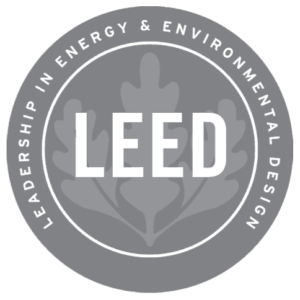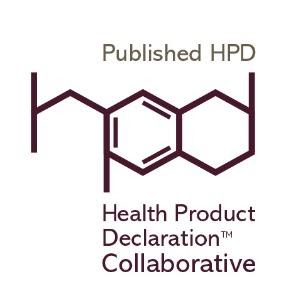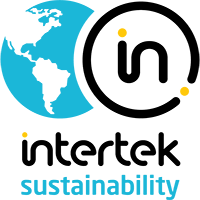Sustainability
Steel: The Green Choice
Steel is 100% recyclable and one of the most recycled materials in the world. It is recycled without any loss of quality, which contributes to steel’s affordability.
When it comes to doors and frames, hollow metal is the obvious choice for green projects due to its infinite recyclability. Hollow metal doors can also withstand more natural and man-made abuse, and easier to maintain than other materials such as wood. When properly installed and maintained, hollow metal doors often last 30 years or longer.
Sustainable Practices by SDI Certified Manufacturers
The Steel Door Institute’s membership is dedicated to sustainability. By adopting green practices, their aim is to consume less, pollute less, and recycle more. This is done by creating energy efficient openings that improve building performance and are produced with recycled materials. Manufacturing doors and frames in the United States also keeps the environmental impact low by having regional manufacturing and distribution centers.
Our SDI member manufacturers embrace various sustainability practices which include:
Recycling waste materials
Reduction of energy usage
Diverting materials from landfills
Overview
Green building isn’t a trend, it’s here to stay and will only become more common. In this changing landscape, architects, building owners, contractors, and distributors are navigating an ocean of terminology and learning new ways to contribute to green building certification programs. This page provides a bird’s eye view of green building practices and how it relates to steel doors and frames.
While doors and hardware typically account for less than 2% of a building project, thoughtfully selected door openings can make significant contributions for design professionals working toward a sustainable built environment. They can also bring additional energy savings for the building owner.
In 2016, the Steel Door Institute worked with Underwriters Laboratories Environment in the development of the first Product Category Rules (PCRs) for steel doors and frames. The Product Category Rules enable manufacturers to conduct Life Cycle Assessments (LCAs) and develop an Environmental Product Declaration (EPDs) to help building projects comply with LEED v4.
LCAs assess the environmental impacts associated with all the stages of a product’s life – from raw material extraction through materials processing, manufacture, distribution, use, repair and maintenance, and disposal or recycling. Design professionals use this process to help critique their products. LCAs include data like the product’s embodied carbon footprint, which is valuable to architects and designers.
It’s not only important – and sometimes mandatory – to build green, but also to effectively document it to contribute toward the appropriate credits. Working with experienced manufacturers will make your job much easier.
SDI Member Manufacturers have a deep understanding of sustainable products and can provide the necessary certification contribution documentation. Their steel doors and frames are highly recyclable, and US manufacturers have a much smaller footprint than those abroad. Consider contacting an SDI manufacturer early in the design phase of your next project with steel doors and frames so they can help you maximize your points.
LEED
LEED (Leadership in Energy and Environmental Design) is the world’s leading green building project and performance management system, delivering a comprehensive framework for green building design, construction, operations, and performance. LEED v4.1 raises the bar on building standards to address energy efficiency, water conservation, site selection, material selection, daylighting and waste reduction.
US Green Building Council’s LEED, is used throughout the world to build healthy and energy-efficient commercial and residential projects. LEED certification is a symbol of sustainability achievement. The major product contributions from doors and frames are found in the Resources category. The requirements in this section encourage the use of sustainable building materials and reducing waste on site to support a “life-cycle approach.”
(Note: This is where SDI Members can help architects contribute.)
Environmental Product Declarations (EPDs)
An EPD is an independently verified and registered document that communicates transparent and comparable information about the life-cycle environmental impact of products. There are different types of EPDs and they can be industry wide as well as product specific. Note: Having an EPD for a product does not imply that the declared product is environmentally superior to alternatives. It is simply a transparent declaration of the life-cycle environmental impact.
The Steel Door Institute completed the first industry-wide Environmental Product Declarations (EPDs) for steel doors. The development of the EPDs was achieved by undergoing a “cradle-to-gate” assessment for two products: heavy duty flush panel steel doors made with a polystyrene core and 5-3/4” 16-gauge steel prime painted door frames.
What does that mean? That these common types of steel doors and frames can contribute toward credit in the LEED v4 Materials Resources category – Building Product Disclosures and Optimization. For more information, see our article in Door & Hardware Magazine.
Environmental Product Declaration documentation:

Product Category Rules (PCRs)
PCRs define the rules and requirements for Environmental Product Declarations (EPDs) within a certain product category. A PCR follows internationally established standards and makes it easier to consistently and transparently. They are essential in the development of environmental declarations because they allow you to compare like products.
For more information about PCRs and EPDs, please contact UL.PCR@ul.com. You can also find products with EPDs in SPOT, UL’s sustainable product database.
Health Product Declarations (HPDs)
Health Product Declaration® (HPD) Open Standard is a reporting format that provides information on products’ content and potential health hazards associated with the products’ materials. HPDs include the substance threshold, the materials and substances contained in a product, the associated hazards of each material or substance, and the VOC content. HPDs can either be self-published or third-party verified.
The HPD Public Repository is the authoritative source for published HPDs. When a manufacturer publishes an HPD using the HPD Builder, it is automatically uploaded to the Repository as a PDF file. Once uploaded, an HPD is considered a “Public HPD.” Architects, Designers, Project Teams, Property Owners, or any interested party can use the public repository. They can search uploaded PDFs and are available to download by users. A simple search capability is available to assist in finding HPDs by Manufacturer, Product Name, CSI Classification, or HPD version.
Intertek
Intertek’s VOC Indoor Air Quality Certification independently tests and certifies products to regulated sustainability initiatives including, but not limited to, BIFMA e3, California CDPH, LEED, and WELL.
Intertek’s Clean Air certification program utilizes an expert team of chemists and ISO 17025 accredited labs to test products for VOC emission compliance. Intertek’s proprietary program provides two classes of certification – Clean Air SILVER and Clean Air GOLD.
Greenguard (UL)
Studies by the US Environmental Protection Agency have found that airborne chemicals commonly known as volatile organic compounds (VOCs) are common in indoor environments and that their levels may be two to a thousand times higher than outdoors. VOCs are used to manufacture and maintain building materials, interior furnishing, cleaning products, and even personal care products.
The UL GREENGUARD Certification Program established test methods and emission limits for these product groups:
- Building materials and furnishings
- Electronic equipment
- Cleaning and maintenance products
- Medical devices for breathing gas pathways
There are two tiers of certification available – GREENGUARD Certification and GREENGUARD Gold Certification. All certified products are subject to a review of the manufacturing process and routine testing to help ensure minimal impact on the indoor environment.
Many industry leading manufacturers have certified their hollow metal door and frame products to GREENGUARD and/or GREENGUARD Gold standards. These certifications also contribute to green building programs like LEED and the WELL Building Standard. All documentation can be found in the UL SPOT database.
Benefits of Indoor Air Quality Certification:
- Measure the environmental impact of product VOC emissions for Indoor Air Quality
- Opportunity to benchmark product components to industry standards
- Compliance to LEED
- Compliance to ANSI/ BIFMA e3 Furniture Sustainability Standard credit 7.6 Low Emitting Furniture
- Promote environmentally friendly sustainable products in the marketplace
Passive Building
Passive Building is a set of design principles for attaining a rigorous level of energy efficiency while creating comfortable indoor living and work spaces. These principles can be applied to all buildings, including single-family homes, multifamily apartment buildings, schools, skyscrapers, and more.
Passive building puts passive house principles into practice to create safe, resilient, comfortable, and – most importantly – energy efficient structures, from commercial to residential to multifamily.
WELL Building Standard
The WELL Building Standard™ is revolutionizing the way people think about buildings. It explores how design, operations, and behaviors within the places we live, work, learn and play can be optimized to advance human health and well-being. Covering seven core concepts of health and hundreds of features, WELL is a flexible building standard and represents the future of modern design.
It is a performance-based system for buildings and organizations to deliver more thoughtful and intentional spaces that enhance human health and well-being by measuring, certifying, and monitoring the built environment.
WELL is managed and administered by the International WELL Building Institute (IWBI).
Embodied Carbon
Embodied carbon refers to the greenhouse gas emissions associated with building construction, including those produced from the extracting, manufacturing, transporting, installing, maintaining, and disposing of building materials. “Cradle to gate” embodied carbon refers to greenhouse gas emissions associated with the production of building materials, from the extraction of raw materials to the manufacture of the finished products. This type of emission is also referred to as supply-chain carbon. This ‘upfront’ emission accounts for the majority of a building’s total embodied carbon. Embodied carbon is a significant percentage of global emissions.
Third-Party Verification
Greenwashing, or the embellishment of sustainability claims, can be common in today’s competitive industry. Many manufacturers utilize a third-party verifier to audit and validate claims made around the sustainability attributes of a product or process. SDI manufacturers collaborate with a number of credible third-party experts. Please contact a SDI Certified Manufacturer for additional information about these verifications and their importance.
Resources
- Environmental Product Declaration website – information on Environmental Product Declarations and Product Category Rules
- Health Product Declaration Collaboration – standard specification for product contents and health information
- Mindful Materials – product sustainability information tool
- SCS Global Services – program operator
- UL SPOT– product sustainability information tool
- US Green Building Council – LEED information
Certification Programs
- Clean Air – Intertek’s VOC testing certification program
- GreenCircle Certified – third-party certifier
- GREENGUARD Certification Program – UL’s VOC testing certification program
- Green Leaf Mark – Intertek’s certification program
Continuing Education
SDI has developed a variety of resources for architects, specifiers and distributors regarding sustainability. Our online course is free of charge and offers AIA and/or GBCI continuing education hours.
GBCI / AIA Course
Sustainability & Steel: Building with Recycled Materials
take online
for 1 GBCI and/or AIA HSW CE hour
SDI Certified Sustainable Manufacturers
The SDI members below are committed to sustainable manufacturing practices. Click the logos for manufacturer-specific information.














